Beyond Liberation: Videha, Prakriti-laya & Three Paths of Freedom – Yoga Sutras 1.18-1.19 (Part 3)
Part 24: Patanjali Yoga Sutra Explained
Beyond Liberation: The Unexpected Danger
In our previous explorations (Part 1: Understanding Asamprajnata Samadhi and Part 2: Practice of Para Vairagya), we discovered that even Viveka-khyati—the discriminative wisdom that clearly perceives Purusha—must be transcended through supreme detachment. We learned the Neti-Neti practice and understood how nirodha samskaras progressively destroy all other mental impressions.
But now comes a startling revelation from the Patanjala Yoga Pradeep commentary:
Even the highest stages of Samprajnata Samadhi can become bondage.
This isn’t theoretical philosophy. The commentary describes actual spiritual states where yogis, having achieved sublime realizations, become stuck—sometimes for cosmic ages—in what appears to be liberation but is actually a golden cage.
Let’s explore these hidden traps and discover the three authentic paths to freedom.
The Two Subtle Bondages: Videha and Prakriti-laya
Understanding Videha State (विदेह)
What is Videha?
The term विदेह (Videha) literally means “without body” or “disembodied.” The commentary explains:
“Those yogis who remain attached to this bliss (of Ananda Samadhi), after leaving the body, experience this bliss for a long time while achieving a Kaivalya-like state in the Asmita condition.”
The Experience:
- The yogi has achieved Ananda Samadhi (bliss-based absorption)
- Experiences असीम आनन्द (boundless bliss) through awareness of Ahamkara (ego-principle)
- The experience is अहङ्काररहित केवल ‘अस्मि’ वृत्ति—the ‘I am’ consciousness without ego-distortion
- Feels infinite, expansive, unbounded
What Happens at Death:
- Due to attachment (आसक्ति) to this sublime bliss
- The yogi leaves the physical body
- Enters the Asmita-avastha (I-am-ness state)
- Experiences Kaivalya-pada-जैसी (Kaivalya-like) condition
- Remains there for extended cosmic periods
Why It’s Still Bondage:
Though appearing similar to liberation, the Videha state is बन्धनरूप (bondage) because:
- Attachment persists – Specifically to Ahamkara (ego-principle)
- Not true Kaivalya – Only Kaivalya-like, not actual Kaivalya
- Prakṛti’s grip remains – Still within the realm of the gunas
- Must eventually return – Like a submerged diver who must resurface
The Sankhya text Tattvasamasa calls this प्राकृतिक बन्ध (natural bondage).
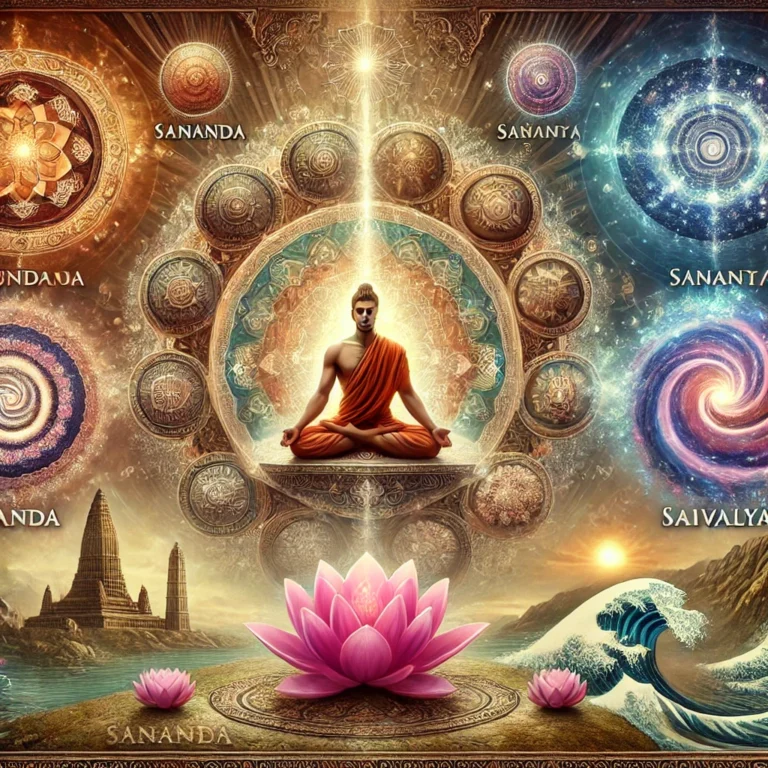
Understanding Prakriti-laya State (प्रकृतिलय)
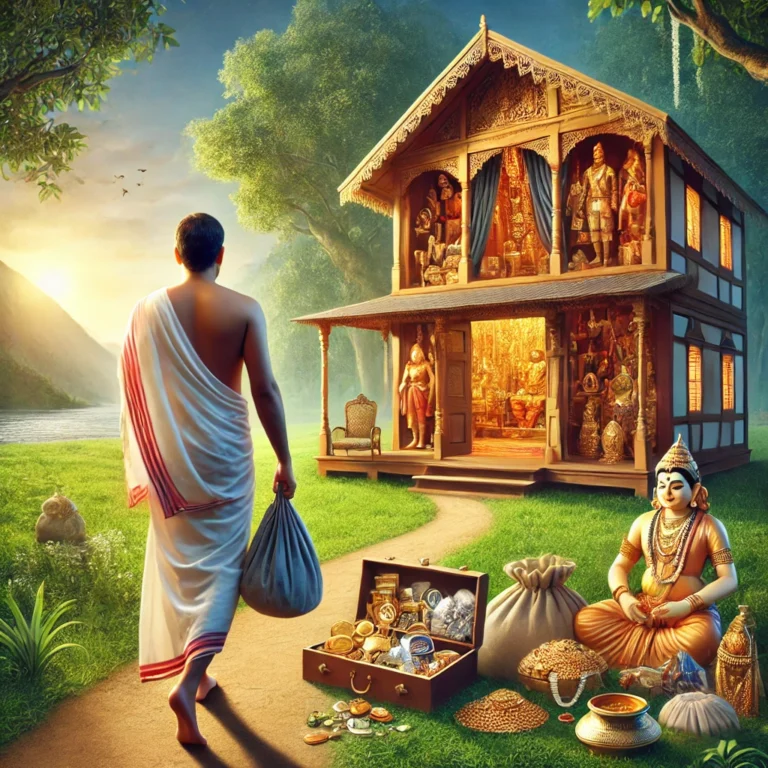
What is Prakriti-laya?
प्रकृतिलय literally means “dissolved in Prakriti” or “merged in nature.” This is an even more subtle and elevated state than Videha.
The Experience:
- The yogi has achieved Asmita Samadhi (pure I-am-ness)
- Attains the महत्तत्त्व (Mahat-tattva) or primordial Chitta-Buddhi
- Experiences consciousness at its most refined material state
- This is गुणोंका प्रथम विषम परिणाम—the first unequal transformation of the gunas
The Paradox:
The commentary states something profound:
“The original Prakriti in the equilibrium state of gunas is only inferential and knowable through scriptures, and is purposeless for Purusha. The actual Prakriti is the first unequal transformation of gunas—Mahat-tattva (Chitta-Buddhi). Therefore, yogis who have attained this Asmita Prakriti are called Prakriti-laya.”
Why This is the Highest “Natural” State:
- It’s असीम आनन्दवाली (of infinite bliss)
- कैवल्यपदके तुल्य (equal to Kaivalya state)
- The subtlest possible material existence
- Beyond the 16 modifications and 5 tanmatras
Yet Still Bondage:
The commentary is unequivocal:
“किंतु बन्धनरूप ही है। वास्तविक कैवल्य नहीं है।” “But it is bondage only. Not actual Kaivalya.”
Why?
- Attachment to Asmita (I-am-ness) remains
- Though freed from gross and subtle modifications
- Prakriti’s बन्ध (bondage) persists
- Must eventually emerge from this state
The Sankhya Perspective: Two Liberations of Sixteen
The Tattvasamasa describes:
- 16 विकृतियाँ (modifications): 11 sense organs, 5 subtle elements
- 5 तन्मात्राएँ (tanmatras): subtle essences of elements
Both Videha and Prakriti-laya transcend these 21 categories, yet:
- Videha retains attachment to Ahamkara
- Prakriti-laya retains attachment to Asmita
The commentary quotes the Tattvasamasa:
“न कारणलयात् कृतकृत्यता मग्नवदुत्थानात्।” “From merging in the cause (Asmita Prakriti), there is no fulfillment (establishment in one’s own nature), because like one who has submerged [in water], one must rise again (return to human realm).”
The Implication: Even cosmic states must eventually be transcended for true liberation.
Although these two states—Videha and Prakriti-laya—represent the highest possibilities within the realm of Prakriti, Patanjali now anticipates a natural question: What becomes of such yogis? Are they bound to the same intense discipline, the same Para Vairagya, the same struggle against samskaras as ordinary seekers?
The commentary acknowledges that not all practitioners stand at the same starting point. Some arrive in this life already bearing the momentum of ancient sadhana.
It is to explain this difference in spiritual inheritance that Patanjali now introduces Sutra 1.19.
Introducing Sutra 1.19: The Natural Adepts
Having understood these subtle bondages, Patanjali now addresses a special category of practitioners:
भवप्रत्ययो विदेहप्रकृतिलयानाम् ॥१.१९॥
Bhava-pratyayo videha-prakṛti-layānām
Translation: “For the Videha and Prakriti-laya [yogis], [attainment comes through] birth/existence as the cause.”
Breaking Down the Sutra
भव (Bhava)
- Literal meaning: Birth, existence, becoming
- Implies: Natural capacity from previous lives
- Technical sense: Innate spiritual momentum
प्रत्यय (Pratyaya)
- Meaning: Cause, means, instrument
- Here: The causative factor for attainment
- Indicates: What brings about their state
विदेह (Videha)
- Those attached to Ananda/Ahamkara
- Disembodied beings in blissful absorption
प्रकृतिलय (Prakṛti-laya)
- Those merged in Asmita-Prakriti
- The highest natural attainment
Combined Meaning: “Those who have previously attained Videha or Prakriti-laya states in past lives carry this capacity as an innate tendency (bhava-pratyaya). They don’t need the same intense effort as ordinary seekers to achieve high meditative states.”
The Sañgati (Connection): Why This Sutra Now?
The commentary explains the logical flow:
Previous Context (Sutra 1.18):
- Described Asamprajñata Samadhi
- Explained how it requires intense practice (abhyāsa) of Para Vairagya
- Showed the demanding path for ordinary practitioners
The Question That Arises: “Do ALL yogis need this same level of effort?”
Sutra 1.19 Answers: No. Yogis who achieved Vichara-anugata (Ananda or Asmita) Samprajnata Samadhi in previous lives don’t need ordinary human effort (पुरुषार्थ). They possess योग्यता (fitness/capacity) from birth to attain Asamprajñata.
The Commentary States:
“जिन योगियोंने पिछले जन्ममें विचारानुगतसे ऊँची आनन्दानुगत अथवा अस्मितानुगत सम्प्रज्ञात-समाधिकी भूमिको प्राप्त कर लिया है, उनको असम्प्रज्ञात-समाधिकी प्राप्तिके लिये अन्य साधारण मनुष्यों-जैसी पुरुषार्थकी अपेक्षा नहीं होती।”
“Yogis who attained stages higher than Vichara-anugata—namely Ananda-anugata or Asmita-anugata Samprajnata Samadhi—in previous births do not need the same human effort as ordinary people to attain Asamprajnata Samadhi.”
Key Point: They are जन्महीसे (from birth itself) equipped due to पिछले योगबल (previous yoga-power).
With the explanation of bhava-pratyaya complete, Patanjali has now mapped the spiritual capacities with which different yogis begin their journey. But capacity alone does not decide destiny.
What ultimately matters is the state of Chitta at the moment of leaving the body, the balance between nirodha-samskaras and vyutthana-samskaras, and the presence or absence of welfare-intention.
The commentary therefore proceeds to the natural next step:
What happens to a yogi who has touched Asamprajñata Samadhi when the body falls away?
This leads us into the profound teaching on the three possible trajectories of liberation.
Before proceeding to the three liberation trajectories, readers who wish to clarify key terms—such as Asamprajnata, Asmita, Prakriti, Samskara, or Bhava-pratyaya—may explore our dedicated Yoga Sutra glossaries below. These entries decode Patanjali’s vocabulary without losing the depth of the original Sanskrit tradition:
• Patanjali Yoga Sutra Glossary — Understanding Yoga Sutra Terms (Part I)
• Patanjali Yoga Sutra Terms Explained — Understanding Yoga Sutra Terms (Part II)
Three Paths After Death: The Complete Picture
The commentary now reveals the full spectrum of possibilities when a yogi who has touched Asamprajñata Samadhi leaves the body:
Path 1: सद्योमुक्ति (Sadyo-mukti) – Immediate Liberation
Who Qualifies: Yogis whose nirodha samskaras have completely destroyed ALL vyutthana samskaras
What Happens:
- At death, चित्तको बनानेवाले गुण अपने-अपने कारणमें लीन हो जाते हैं
- The gunas composing Chitta dissolve into their causes
- द्रष्टा शुद्ध चेतन परमात्मस्वरूपमें अवस्थित हो जाता है
- The Seer (Purusha) becomes established in pure conscious Supreme Self nature
- This is Kaivalya
The Upanishadic Description:
The commentary quotes Brihadaranyaka Upanishad (4.4.6):
“योऽकामो निष्काम आप्तकाम आत्मकामो न तस्य प्राणा उत्क्रामन्ति ब्रह्मैव सन् ब्रह्माप्येति।”
“One who is without desires, who is beyond desires, whose desires are fulfilled, or who desires only Atman—their pranas (life-forces and senses) do not depart. Being Brahman itself, they merge into Brahman.”
The Beautiful Paradox:
- The pranas don’t “leave” at death
- Because there’s no separate individual to leave
- ब्रह्मैव सन्—already being Brahman
- Simply recognizes what always was
Path 2: क्रममुक्ति (Krama-mukti) – Gradual Liberation via Āditya-loka
Who Qualifies: Yogis who have:
- Achieved Asamprajñata Samadhi
- BUT some vyutthana samskaras still remain (कुछ शेष रह गये हैं)
- Not yet completely destroyed all seeds
What Happens: They attain आदित्यलोक (Āditya-loka), and their path is called उत्तरायण (Uttarayana/Devayana)
Critical Clarification:
The commentary is emphatic that this is NOT:
- ❌ The physical sun
- ❌ Some subtle celestial realm like those in Vichara Samadhi
- ❌ A place you travel to
What Āditya-loka Actually Is:
“वह विशुद्ध सत्त्वमय चित्त है, जिसको हमने ईश्वरके चित्तके नामसे कई स्थानोंमें वर्णन किया है”
“It is the pure Sattva-predominant Chitta which we have described in many places as Ishvara’s Chitta.”
The Process:
- At death, consciousness becomes अन्तर्मुख (inward-turned)
- Merges into विशुद्ध सत्त्वमय चित्त (Ishvara’s pure sattvic Chitta)
- There, through अमानव ईश्वर’s grace (non-human Ishvara’s grace)
- Remaining vyutthana samskaras are निवृत्त (removed)
- Eventually, gunas dissolve into their causes
- Purusha attains परमात्मस्वरूपमें अवस्थिति (establishment in Supreme Self)
Not a Physical Journey:
The commentary warns:
“देवयान अथवा उत्तरायणको भौतिक-जैसी गतिका अनुमान न करना चाहिये”
“One should not conceive of Devayana or Uttarayana as a physical-like movement.”
Why? Because:
- मार्ग और गति बाहरकी वस्तुओंमें होती है—Path and movement apply to external objects
- This is an internal transformation
- अन्तर्मुख होना—Becoming inward-turned into Ishvara’s Chitta
Vedanta Sutra Confirmation:
The commentary quotes Vedanta Sutra (4.3.10):
“कार्यात्यये तदध्यक्षेण सहातः परमाभिधानात्।”
“Having reached Brahma-loka (Āditya-loka = pure sattvic Chitta), transcending the effect [qualified Brahman], one enjoys sovereignty together with that overseer who is beyond—the Supreme Brahman.”
Timeline: This is a progressive path, hence called Krama-mukti (gradual liberation).
Path 3: अवतार (Avatāra) – Return for World Welfare

The concept of Avatāra reveals a profound truth in Patanjali’s system: liberation and compassion are not mutually exclusive. This Dharmic idea—that spiritual attainment naturally expresses itself as world-welfare—is central to the ancient Vedic ideal of Vasudhaiva Kutumbakam. The yogi’s inner freedom becomes a source of outer upliftment.
Explore the ancient Hindu principle of “the world is one family” and its relevance for global harmony today.
Who Qualifies: Yogis who have:
- Achieved स्वरूप-अवस्थिति (establishment in essential nature)
- Destroyed ALL vyutthana samskaras through Asamprajñata
- BUT retain कल्याण संकल्प (welfare-intention) for beings
The Unique Situation:
“उनके चित्तमें प्राणियोंके कल्याणका संकल्प बना हुआ है”
“In their Chitta, the intention for welfare of beings remains.”
What Happens:
- Their Chitta’s gunas don’t dissolve into causes
- Their vast sattvic Chitta merges into Ishvara’s Chitta
- Due to समान संकल्प (similar intention)—both concerned with universal welfare
- They remain established कैवल्यपदके सदृश (similar to Kaivalya state)
- In शुद्ध चेतन परमात्मस्वरूप (pure conscious Supreme Self form)
When the World Needs Them:
“ईश्वरीय नियमानुसार संसारके कल्याणमें जब उनकी आवश्यकता होती है तो वे इस भौतिक जगतमें अवतीर्ण होते हैं”
“According to divine law, when their necessity arises for world welfare, they descend into this material world—in other words, they take Avatāra.”
The Bhagavad Gita Connection:
The commentary quotes Gita 4.7-8:
“यदा यदा हि धर्मस्य ग्लानिर्भवति भारत।
अभ्युत्थानमधर्मस्य तदात्मानं सृजाम्यहम्॥
परित्राणाय साधूनां विनाशाय च दुष्कृताम्।
धर्मसंस्थापनार्थाय सम्भवामि युगे युगे॥”
“O Bharata! Whenever there is decline of dharma and rise of adharma, I manifest myself. For the protection of the good, for the destruction of evildoers, for the establishment of dharma, I appear age after age.”
The Mechanism Explained:
- They move from शुद्ध स्वरूप (pure form) to शबल स्वरूप (mixed form)
- From निर्गुण (beyond gunas) to सगुण (with gunas)
- From अव्यक्त (unmanifest) to व्यक्त (manifest)
- Taking भौतिक जगतमें अवतार (incarnation in material world)
Examples Given:
The commentary references Kapila Muni:
“आदिविद्वान् निर्माणचित्तमधिष्ठाय कारुण्याद् भगवान् परमर्षिरासुरये जिज्ञासमानाय तन्त्रं प्रोवाच।”
“The original knower, Bhagavan Parama Rishi (Kapila Muni), presiding over Nirmana-chitta (Chitta free from worldly impression-samskaras), out of compassion, taught the Sankhya Tattvasamasa tantra to the inquiring Asuri Muni.”
Also referenced:
“ऋषिप्रसूतं कपिलं यस्तमग्रे ज्ञानैर्बिभर्ति।”
“[Ishvara] fills with knowledge that Kapila who was born first among rishis.”
The Key Difference:
- Not reincarnation due to karma
- Not rebirth due to remaining attachments
- But conscious, compassionate return
- While maintaining inner liberation
Viveka-Khyāti: The Mechanism of Final Freedom
Having understood the three paths, let’s examine how Viveka-khyati (discriminative wisdom) prepares the ground for liberation.
How Viveka-Khyāti Destroys the Kleshas
The commentary provides precise mechanics:
The Foundation – Asmita-Klesha:
“अस्मिता-क्लेश ही राग, द्वेष और अभिनिवेश क्लेश तथा सकाम कर्म, उनके फलोंकी वासनाएँ, उनके अनुसार जन्म-आयु-भोग तथा उसमें सुख-दुःखका कारण है।”
“Asmita-klesha is the cause of Raga, Dvesha, and Abhinivesha kleshas, as well as desire-motivated action, impressions of their fruits, corresponding birth-life-experience, and pleasure-pain therein.”
The Root – Avidya-Klesha:
“इसकी जननी अविद्या-क्लेश है, जो सत्त्व चित्तमें लेशमात्र तमसमें बीजरूपसे वर्तमान रहती है।”
“Its mother is Avidya-klesha, which remains in Sattva Chitta as a seed in trace Tamas.”
What Viveka-Khyāti Does:
- Creates Pure Discrimination:
- Between त्रिगुणात्मक जड चित्त (three-gunad inert Chitta)
- And गुणातीत चैतन्यस्वरूप पुरुष (guna-transcendent conscious Purusha)
- Eliminates Asmita-Klesha:
- The false identification dissolves
- Pure awareness of distinction arises
- Burns All Other Kleshas:
“अविद्या-क्लेश अपने अन्य सब क्लेशरूपी परिवारसहित दग्धबीज-तुल्य हो जाती हैं”
“Avidya-klesha, along with its entire family of other kleshas, becomes like burnt seeds.”
The Transformation of Tamas:
Here’s something beautiful:
“अब वही लेशमात्र तमस् जिसमें अविद्या वर्तमान थी, इस सात्त्विक वृत्ति (विवेकख्याति) को स्थिर रखनेमें सत्त्वका सहायक हो जाता है।”
“Now that very trace Tamas in which Avidya existed becomes supportive of Sattva in stabilizing this sattvic vritti (Viveka-khyati).”
The Irony:
- The substrate that held ignorance
- Becomes the support for wisdom
- Tamas serves Sattva
- Darkness becomes the ground for light
The Final Release: Why Even Viveka-Khyāti Must Go
The Ultimate Paradox:
The commentary states clearly:
“आत्मसाक्षात्कार करानेवाली यह विवेकख्याति भी चित्तहीकी सबसे उच्चतम सात्त्विक वृत्ति है।”
“This Viveka-khyati which causes Self-realization is also Chitta’s highest sattvic vritti only.”
The Mirror Returns:
“जिस प्रकार दर्पण (शीशा) में दिखलायी देनेवाला स्वरूप वास्तविक स्वरूप नहीं होता है, इसी प्रकार चित्तमें आत्माका साक्षात्कार वास्तविक स्वरूप-अवस्थिति नहीं है।”
“Just as the form seen in a mirror is not the real form, similarly the realization of Atman in Chitta is not actual establishment in one’s own nature.”
Therefore:
“इस प्रकार विवेकख्यातिसे भी आसक्तिका हट जाना परवैराग्यद्वारा होता है।”
“Thus the removal of attachment even from Viveka-khyati happens through Para Vairagya.”
This Leads To: असम्प्रज्ञात अथवा निर्बीजसमाधि—Asamprajñata or Nirbija Samadhi
To understand how these states relate to the full yogic journey, see the structural maps at the end of this article. They visually lay out the layers of samadhi, samskara dynamics, klesha hierarchy, and the Sankhya framework Patanjali uses to define liberation.
Practical Integration: What This Means for Your Practice
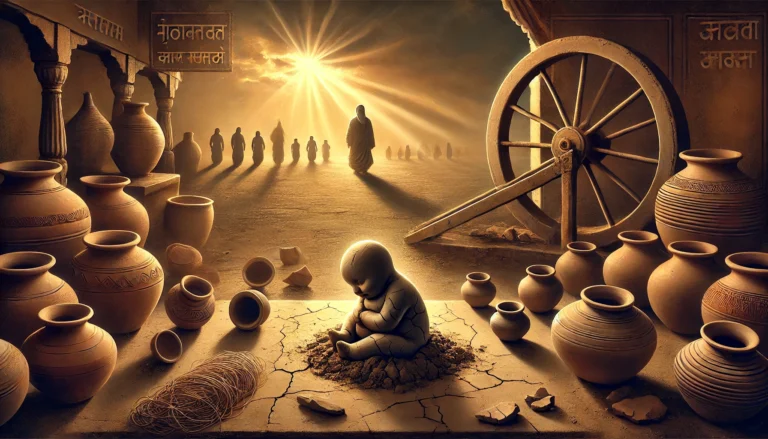
The Yoga Sutras ultimately ask a simple yet radical question: What does it mean to be truly human? Patanjali shows that the mechanical mind, driven by samskaras, is a defective product—one that must be transcended. This broader philosophical inquiry into the human condition echoes across Dharmic literature and modern reflections alike.
Recognizing Subtle Attachments
Question for Self-Inquiry:
- Am I attached to the bliss of meditation?
- Do I crave the peace of deep states?
- Have I become identified with “being spiritual”?
- Do I feel superior due to attainments?
The Videha Warning: Even experiencing yourself as infinite bliss-consciousness can become a trap if attachment forms.
The Prakriti-laya Warning: Even resting in pure I-am-ness can become bondage if you settle there.
Understanding Your Spiritual Inheritance
Signs of Bhava-Pratyaya (Past-Life Yoga):
- Natural draw to meditation from childhood
- Rapid progress without much instruction
- States arising spontaneously
- Feeling of “remembering” rather than learning
- Deep resonance with yogic texts upon first reading
Important: This doesn’t mean you can skip practice! It means your practice will be extraordinarily fruitful.
The Three Gates Ahead
As you progress in Asamprajñata practice, you’re preparing for one of three outcomes:
1. Complete Now (Sadyo-mukti):
- If all seeds burned
- Total establishment in Purusha
- No return
2. Complete Later (Krama-mukti):
- If traces remain
- Merge in Ishvara’s Chitta
- Final liberation after purification
3. Return to Serve (Avatāra):
- If welfare-intention remains
- Maintain liberation while manifesting
- Come back for others
The Key: All three transcend the cycle—they’re just different expressions of freedom.
Common Misunderstandings Clarified
Misunderstanding 1: “Videha/Prakriti-laya are Bad”
Correction: They’re sublime states, far beyond ordinary consciousness. They’re called “bondage” only relative to absolute Kaivalya. They represent tremendous spiritual achievement—just not the final goal.
Misunderstanding 2: “Āditya-loka is Heaven”
Correction: It’s not a place but a state—merging into Ishvara’s pure sattvic consciousness. Not a reward but a purification process.
Misunderstanding 3: “Only Special Souls Get Bhava-Pratyaya”
Correction: You’re building bhava-pratyaya for your next life right now through consistent practice. Every session of meditation creates spiritual momentum.
Misunderstanding 4: “Avatāras are Different from Liberated Beings”
Correction: Avatāras ARE liberated beings who choose to maintain a functional relationship with Prakriti for compassionate purposes. Inner liberation + outer engagement.
Misunderstanding 5: “I Should Choose Which Path”
Correction: The path chooses itself based on your deepest nature and remaining samskaras. Your job is sincere practice, not outcome-planning.
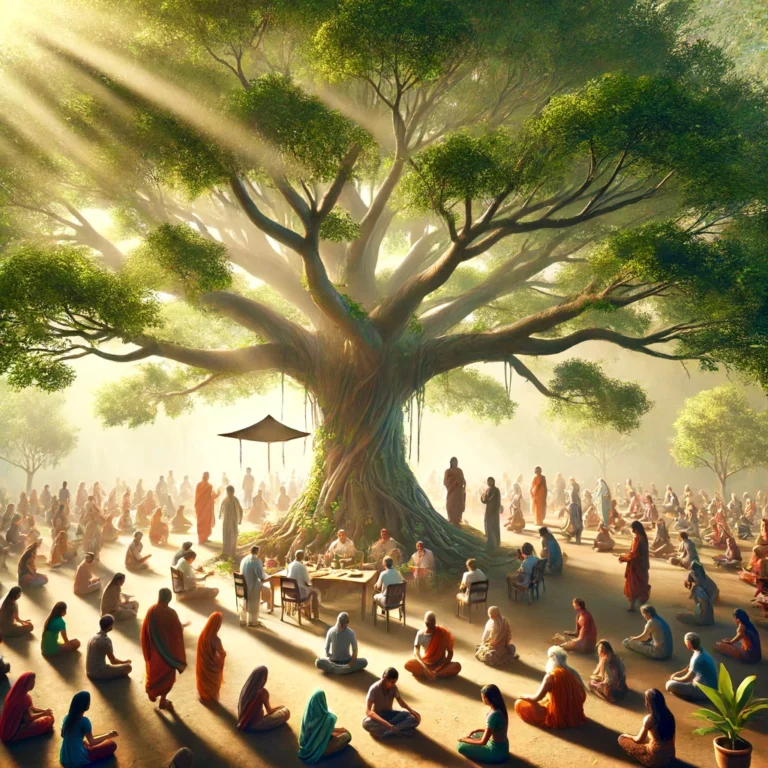
Sanatana Dharma — Secular and Inclusive Values of Hindu Philosophy
Patanjali’s map of consciousness is not isolated; it emerges from the larger civilizational framework of Sanatana Dharma. The same principles that guide Yogic liberation also inform Hinduism’s ethical, inclusive, and universal worldview. To appreciate Patanjali fully, one must understand the Dharmic foundation from which it arises.
Discover the universal, secular, and inclusive principles at the heart of Hindu philosophical thought.
The Complete Journey: Sutras 1.18-1.19 Synthesized

Let’s see the full architecture:
For Ordinary Practitioners (Most of Us):
- Practice Abhyasa-Vairagya (Sutras 1.12-1.16)
- Progress through Samprajñata stages (Sutra 1.17)
- Cultivate Para Vairagya through Neti-Neti (Sutra 1.18)
- Touch Asamprajñata momentarily
- Repeat daily—strengthen nirodha samskaras
- Gradually stabilize in cessation
- Three possible outcomes at death
For Those with Bhava-Pratyaya (Sutra 1.19):
- Natural capacity from previous births
- Rapid access to higher Samprajñata stages
- Less effort needed for Asamprajñata
- Still must practice Para Vairagya
- Same three outcomes available
The Ultimate Resolution:
- Whether through intense effort or natural capacity
- Whether immediate, gradual, or returning
- All authentic paths lead to स्वरूप-अवस्थिति
- Establishment in one’s essential nature
- This is Kaivalya
Closing Reflection: The Compassionate Architecture of Yoga

This section forms one strand of Patanjali’s immense architecture of liberation. For readers who want the entire journey in one place—from the first definition of Yoga to the final dissolution of samskaras—the full guide offers an integrated path.
What becomes clear from these sutras is Patanjali’s profound compassion:
He Shows Us:
- Even near the summit, pitfalls exist (Videha/Prakriti-laya)
- Even achieved states can become bondage
- Attachment is subtle and pervasive
- Para Vairagya must be radical
But Also:
- Multiple paths exist to freedom
- Past efforts never waste (bhava-pratyaya)
- Even “incomplete” liberation serves purification (Krama-mukti)
- The option to return and serve remains (Avatāra)
- The goal is achievable by all
The Message: Walk carefully, practice sincerely, hold lightly even the highest attainments, and trust the process completely.
Key Takeaways
✓ Videha and Prakriti-laya are sublime but not final—attachment to bliss or I-am-ness keeps subtle bondage
✓ Sutra 1.19 addresses those with natural spiritual capacity from previous lives (bhava-pratyaya)
✓ Three liberation paths exist: Sadyo-mukti (immediate), Krama-mukti (gradual via Īshvara’s Chitta), Avatāra (return for service)
✓ Āditya-loka is not a place but Īshvara’s pure sattvic consciousness where final purification occurs
✓ Viveka-khyāti destroys all kleshas by making them burnt seeds, but itself must be transcended
✓ Even the mirror of wisdom must dissolve for true establishment in Purusha’s nature
✓ All authentic paths lead to Kaivalya—whether through different routes or timings
Connection to Next Sutra
Having explored those with natural capacity (bhava-pratyaya), Patanjali will next address in Sutra 1.20 the specific practices for those WITHOUT such inheritance—the path of:
- Shraddha (faith)
- Vīrya (energy)
- Smriti (memory)
- Samādhi (absorption)
- Prajñā (wisdom)
The five essential qualities for ordinary practitioners to achieve what natural adepts get through birth.
Continue Your Journey:
Feature Image: Click here to view the image.
Glossary of Key Terms
- Videha (विदेह): Disembodied state where yogis attached to Ananda Samadhi experience prolonged bliss after death
- Prakriti-laya (प्रकृतिलय): State of dissolution in primordial nature (Mahat-tattva); highest material existence
- Bhava-pratyaya (भवप्रत्यय): Natural spiritual capacity arising from previous birth’s yoga practice
- Sadyo-mukti (सद्योमुक्ति): Immediate liberation at death when all samskaras are destroyed
- Krama-mukti (क्रममुक्ति): Gradual liberation via merging in Īshvara’s consciousness (Āditya-loka)
- Avatāra (अवतार): Liberated being who returns to manifest form for world welfare
- Āditya-loka (आदित्यलोक): Not physical sun but Īshvara’s pure sattvic consciousness
- Viveka-khyāti (विवेकख्याति): Discriminative wisdom perceiving distinction between Purusha and Prakriti
- Dагdha-bīja (दग्धबीज): Burnt seeds—kleshas rendered unable to sprout through discrimination
- Kल्याण-saṅkalpa (कल्याण-संकल्प): Welfare-intention that causes liberated beings to return
- Nirmāṇa-citta (निर्माण-चित्त): Mind free from worldly samskaras; pure instrument for teaching
#YogaSutra #Kaivalya #Videha #Liberation #HinduinfoPedia, #PrakritiLaya #Liberation #Meditation #HinduinfoPedia #PatanjaliYogaSutraExplained
Reference
This blog is based on Patanjala Yoga Pradeep by Swami Omanand.
Related Blogs
- Vedic science and its legacy
- Hindu Sacred Texts: The Building Blocks of Hinduism
- Yoga Day and Ashtanga Yoga In Hindu Philosophy
- Patanjali and His Ashtanga Yoga
- Patanjali Yoga Sutras: Understanding “Atha Yoganushasanam”
- Patanjalis yoga sutra: Understanding Yogashchittavrittinirodhah
- Yoga Learning: Unraveling ‘Yogashchittavrittinirodhah’
- Yoga Rupe Vritti – Managing Mind Modifications through Yoga
- Yoga and Vritti Types: Navigating Mental Modifications
- Yoga Sutras’ Five Vrittis: Mastering Mind Through Ancient Wisdom
- Yoga Sutras’ Pramana Vritti: Exploring Sources of True Knowledge
- Yoga Sutras’ Viparyaya Vritti: Misconceptions and Clarity
- Yoga Sutras’ Vikalpa Vritti: Unraveling Mind’s Illusions
- Yoga Sutras’ Sleep Vritti: Unveiling the Depths of Conscious Rest
- Yoga Sutras’ Memory Vritti: Unraveling the Threads of Recall
- Yoga Sutra Practice Non-Attachment: Mastering Mind and Embracing Tranquility
- Yoga Vritti Restraint Method: Mastering Mindful Discipline
- Yoga Long Term Discipline: Mastering the Art of Sustained Practice
- Yoga Renunciation of Desires: A Path to Inner Peace
- Yoga Beyond Gunas Attachment: Unlocking the Secrets of Sutra
- Samadhi Stages Unfolded: Samadhi Practice- Yoga Sutra 1.17
- https://hinduinfopedia.org/beyond-cognitive-samadhi-understanding-asamprajnata-samadhi/
- https://hinduinfopedia.org/practice-of-para-vairagya-yoga-sutra/
- https://hinduinfopedia.org/patanjali-yoga-sutra-glossary-understanding-yoga-sutra-terms-i/
- https://hinduinfopedia.org/patanjali-yoga-sutra-terms-explained-understanding-yoga-sutra-terms-ii/
Follow us:
- English YouTube: https://www.youtube.com/@Hinduofficialstation
- Hindi YouTube: https://www.youtube.com/@HinduinfopediaIn
- X: https://x.com/HinduInfopedia
- Instagram: https://www.instagram.com/hinduinfopedia/
- Facebook: https://www.facebook.com/Hinduinfopediaofficial
- Threads: https://www.threads.com/@hinduinfopedia
Visual Concept Maps: From Mind to Liberation
Visual Concept Maps
The Samadhi Ladder
→
→
→
→
→
→
The Samskara Cascade
samskaras
samskaras
samskaras
samskaras
The Klesha Hierarchy
(root/ignorance)
(ego)
(attachment)
(aversion)
(fear of death)
The Sankhya Structure
(consciousness)
≠
(matter/mind)
(cosmic intelligence)
(ego)
(modifications + subtle elements)
(physical manifestation)



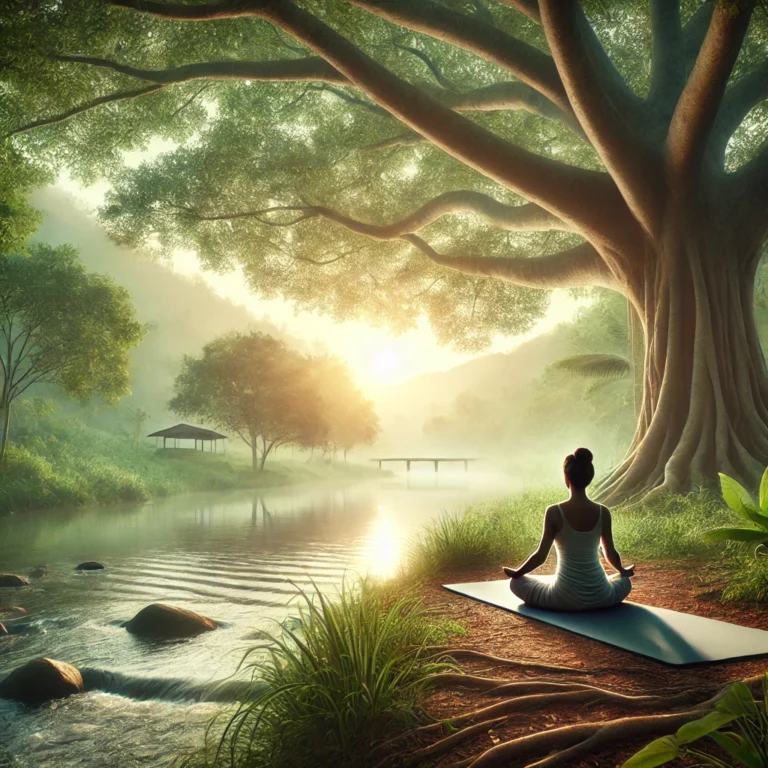
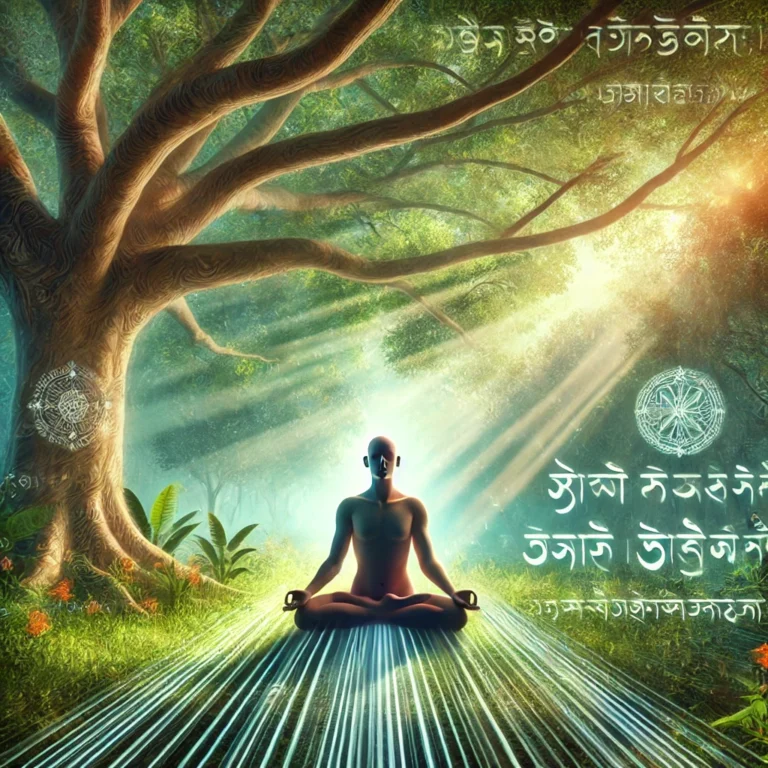
Leave a Reply